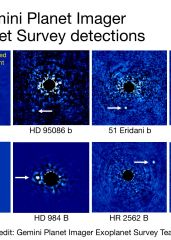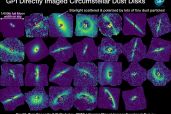The Gemini Planet Imager Exoplanet Survey (GPIES) recently completed its 4-year search for light emitted by gas giant planets around 531 of the nearest, youngest stars to the Sun. Results from this direct imaging search turned up six giant exoplanets and four brown dwarfs, and indicate that planets slightly more massive and farther from their star than Jupiter are relatively rare around Sun-like stars. The survey also detected "debris disks" of tiny dust particles containing the rocky leftovers of planet formation around 29 of the stars, most of which showed ring shapes that could indicate smaller (as yet unseen) inner planets clearing out dust close to the star. More discoveries will be coming from the Gemini Planet Imager as its hardware is upgraded and it is moved from Chile to Hawai'i for new observations.
More news about GPIES can be found on its website: http://planetimager.org
Watch last week's Facebook Live: Gemini Planet Imager and the Search for Young Worlds with Simon Steel and Tom Esposito below.







